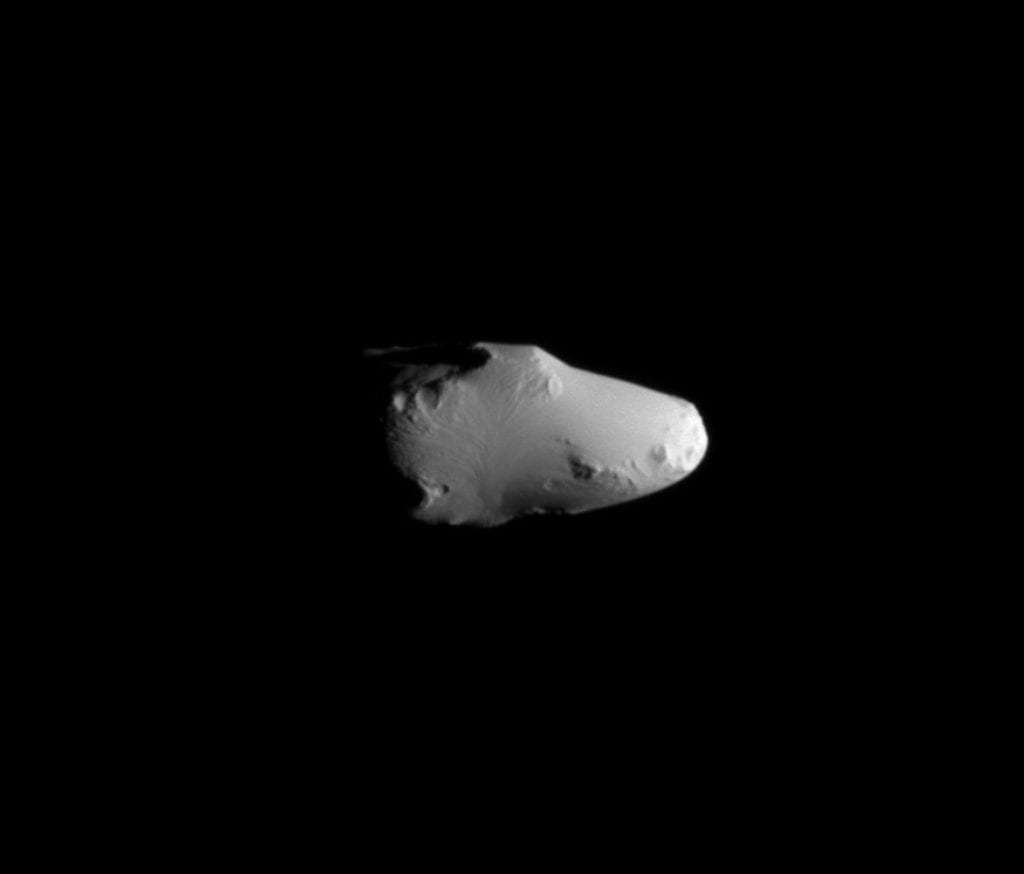What is a Trojan Moon?
A trojan moon – such as the Calypso Moon – is a natural satellite that shares an orbit with another astronomical object. This co-orbiting body lies in, or close to, one of the two stable regions of the Lagrange points.
The Lagrange Points
 The Lagrange points (Lagrangian points) are certain positions in space. They exist in a system of two astronomical bodies like a star and its planet. Think of the Sun and the Earth for example. They are also found in a planet-moon relationship, like in Saturn and one of its moons.
The Lagrange points (Lagrangian points) are certain positions in space. They exist in a system of two astronomical bodies like a star and its planet. Think of the Sun and the Earth for example. They are also found in a planet-moon relationship, like in Saturn and one of its moons.
There are five Lagrangian points, labeled L1, L2, L3, L4, and L5. In these regions, the gravitational pull between the two objects in the system equates to the centripetal force needed for a third small object to move relative to them. Because of this, NASA describes them as like “parking lots” for spacecraft. This will allow the spacecraft to stay in position without using much of its fuel.
Only two of the Lagrangian points are stable, the other three are not.
Did You Know?
The Lagrange points are important in celestial mechanics. It is named after an equally important person, Josephy-Louis Lagrange.
The Italian-French mathematician and astronomer made major contributions in the field of mechanics and number theory. He discussed the “General Three-Body Problem” in his 1772 paper.
Unstable Points
L1, L2, and L3 are unstable points. They are in the same line as the two big orbiting bodies.
In the Sun-Earth system, L1, and L2 have been (or will be) home to some spacecraft and satellites from our planet. These points allow observation while being close to Earth. However, they are unstable for about 23 days so satellites have to adjust and make some orbital maneuvers.
Some Spacecrafts and Satellites in the Unstable Lagrangian Points
L1
Solar and Heliospheric Observatory Satellite (SOHO)
L2
Wilkinson Microwave Anisotropy Probe (WMAP)
ESA Planck
James Webb Space Telescope
L3
*No spacecraft has parked in L3 yet.
Stable Points
The stable Lagrangian points are L4 and L5. They are located 60 degrees ahead and behind the smaller orbiting body, respectively. This equilibrium exists given that the ratio between the masses of the two large bodies is more than 24.96.
Because of their balanced nature, natural objects tend to swarm around L4 and L5. The objects in these stable points are called trojans.
The most prominent trojan asteroids in the solar system are the Jupiter trojans. These asteroids share an orbit with the planet Jupiter. But they never collide because they stay in two big groups, 60 degrees ahead and 60 degrees behind the gas giant.
- Leading trojans: 60° ahead
- Trailing trojans: 60° behind

Did You Know?
Trojans were also found in the systems of Neptune, Uranus, Saturn, Mars, and Earth.
What makes the trojans in the Saturn system is that they are not asteroids but moons. So far, there is nothing like it in the solar system!

The Calypso Moon
Calypso Moon: Facts and Figures
All About the Name
- Pronunciation – /kəˈlɪpsoʊ/
- Behind the name – Kalypsō (The nymph who detained Odysseus on the island Ogygia)
- Adjective – Calypsoan/ Calypsonian
- Other designation/s – Saturn XIV; Tethys C
- Provisional designation – S/1980 S 25
Discovery Details
- Discoverer/s –
- D. Pascu
- P.K. Seidelmann
- W. Baum
- D. Currie
- Discovery date – March 13, 1980
Orbital Characteristics
- Parent Planet – Saturn
- Orbital period – 1.887802 day/s (45 hours)
- Average Orbit Distance – 294,710 km
- Mean Orbit Velocity – 40,865.9 km/h
- Orbital Eccentricity – 0.0005
- Orbital Inclination – 1.56° (to Saturn’s equator)
Physical Features
- Dimensions – 30.2 × 23 × 14 km
- Equatorial radius – 10.7 ± 0.7 km
- Equatorial circumference – 67.2 km
- Volume – 5,131 km3
- Mass – 2,547,736,336,265,230 kg
- Surface area – 1,438.72 km2
- Density – 0.5 g/cm3
- Surface gravity – 0.001 m/s2
- Rotation – Synchronous
- Axial tilt – Zero
- Visual Geometric Albedo – 1.34
- Apparent Magnitude – 18.0
Calypso Moon Features
Calypso is a small moon of Saturn. It was discovered in 1980. It is also known as Saturn XIV.
This moon was given the provisional designation S/1980 S 25 after it was discovered. It was given the permanent name Calypso in 1983, as approved by the International Astronomical Union. The name follows the convention that the moons of the ringed planet be named after the Titans and other characters of Greek mythology.
Calypso lies in Saturn’s E ring. It is a trojan moon of the much larger Tethys. This property of the moon was first observed in 1981.
Specifically, Calypso is a trailing trojan. It lies in the L5 point of Tethys, or 60 degrees behind the planet. Another trojan moon, Telesto, lies in the same orbit but is 60 degrees ahead. Together, the two moons are called “Tethys trojans.”
The other pair of trojan moons in Saturn share the orbit of the moon Dione. Its leading trojan is Helene while the trailing trojan is Polydeuces.
Discovery
Unlike other moons that were detected only by the Cassini spacecraft when it explored Saturn, Calypso was discovered through ground-based observations. It was discovered on March 13, 1980.
A team of four astronomers discovered Calypso. They are Dan Pascu, P. Kenneth Seidelmann, William A. Baum, and Douglas G. Currie.
After discovery, Calypso’s existence was confirmed up close when it was seen by space probes exploring the Saturnian system. In August 1981, Voyager 2 snapped an image of this little moon. It was seen once again by the Cassini probe in 2005.
Cassini’s close-up shot taken in 2010 is our best image of this moon. The probe used its narrow-angle camera to capture the moon in great detail.
Did You Know?
The discovery of the Tethys trojans, Telesto and Calypso, was twinning in many ways.
Both of them were discovered in the same year using the same method!
Characteristics
Size
Calypso’s mean radius is 10.7 km or about 6.6 miles. It is 1.2 times smaller than the other trojan of Tethys, Telesto. The larger moon Tethys has a mean radius of 533.0 km or nearly 50 times bigger than Calypso.
The dimensions of Calypso are 30.2 × 23 × 14 km.
Composition
Calypso’s composition is still unknown. However, its high albedo indicates the presence of water ice particles on its surface.
Orbit
Calypso orbits at a distance of 295,000 km from Saturn. It completes its journey around the ringed planet in nearly two Earth days or 45 hours.
It orbits Saturn in a prograde motion, the same direction that the planet rotates.
Calypso is in a synchronous rotation with Saturn. As a result, the same side of Calypso will always face the planet while the other side will permanently remain in the dark. This phenomenon is called tidal locking. Our Moon also has the same relationship with Earth.
Role
Calypso is an L5 Tethys trojan. It is bombarded with the water ice particles of the E ring. This contributes to its high albedo which is 1.34, making it a very reflective body.
Its apparent magnitude s 18.0, too faint to see with the naked eye. So far, no ring was formed in the orbit of this moon.
What Does Calypso Look Like?
Calypso has an irregular shape, just like the other small Saturnian moons. One of the most remarkable features of this moon is its high albedo or reflectivity. In fact, it is considered one of the most reflective bodies in the solar system.

This potato-looking body has large craters. These prominent features are contrasted with the generally smooth appearance of the moon.
Calypso’s high reflectivity and smooth surface are caused by particles of the E ring that settled on the moon. The ring’s material fills the small craters and other minor imperfections on its surface. Due to these particles being water ice from Enceladus’s geysers, the small moon has a high albedo.
Behind the Name
The temporary designation for this moon was S/1980 S 25. It is also called Tethys C as it is a trojan of Tethys.
Anatomy of a Provisional Designation
The first “S” in Calypso’s provisional designation indicates that it is a natural satellite. The number next to it is the year of discovery. The second “S” is the first letter of the planet’s name, Saturn. And the last number indicates that it is the 25th satellite discovered that year in the Saturnian system.
The name Calypso was awarded for this moon in 1983, just a few years after its discovery. It is based on a nymph in Greek mythology. Calypso means “she who conceals.”
Calypso the Nymph
 Calypso’s parents are the Titan Atlas and the Oceanid Pleione. She lives on the island of Ogygia where Odysseus (Ulysses) washed ashore after a shipwreck.
Calypso’s parents are the Titan Atlas and the Oceanid Pleione. She lives on the island of Ogygia where Odysseus (Ulysses) washed ashore after a shipwreck.
The hero became Calypso’s lover and she managed to keep him on the island for seven years. Soon, Odysseus wanted to get out of the island to be with Penelope, his wife, but the nymph would not let him go.
Odysseus asked for help from the gods for his release. Athena and Zeus helped him by sending the messenger god Hermes to order the hero’s release. Calypso was left with no choice and, at last, released Odysseus.
Statistical Sources:
- https://en.wikipedia.org/wiki/Calypso_(moon)
- https://solarsystem.nasa.gov/moons/saturn-moons/calypso/in-depth/
- https://solarsystem.nasa.gov/moons/saturn-moons/calypso/by-the-numbers/
- https://solarsystem.nasa.gov/resources/754/what-is-a-lagrange-point/
- https://www.go-astronomy.com/planets/saturn-moon-calypso.htm
Image Sources:
- Lagrange points: https://solarsystem.nasa.gov/resources/754/what-is-a-lagrange-point/
- Jupiter trojans: https://en.wikipedia.org/wiki/Jupiter_trojan
- Calypso: https://solarsystem.nasa.gov/moons/saturn-moons/calypso/in-depth/
- What it looks like: https://en.wikipedia.org/wiki/Calypso_(moon)
- Calypso nymph: https://en.wikipedia.org/wiki/Calypso_(mythology)